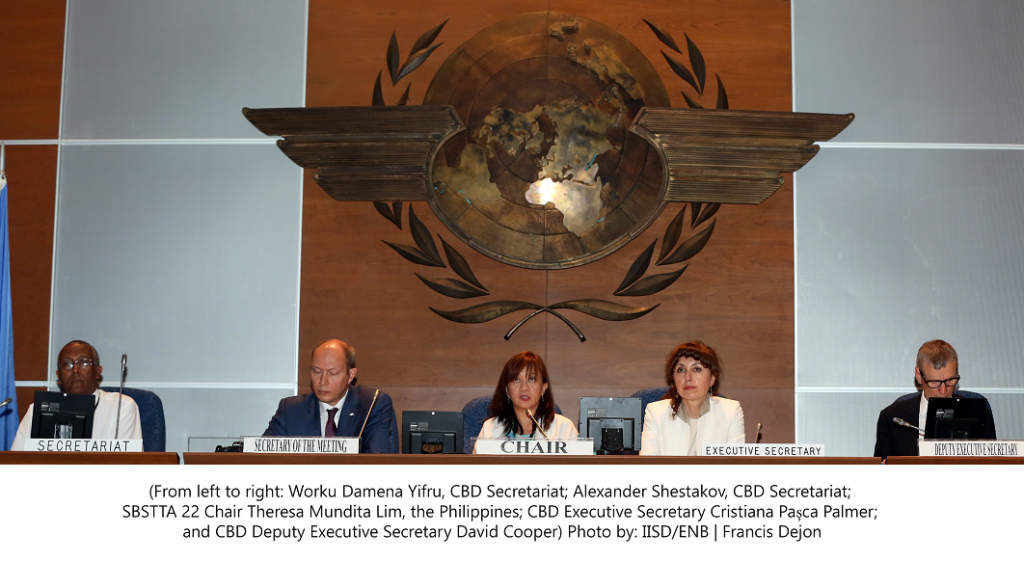
MONTREAL, 2 July 2018 - Convention on Biological Diversity (CBD) parties - including ASEAN Member States - discussed importance efforts in implementing biodiversity conservation commitments at the national level at an ongoing meeting in Montreal.
The CBD held the 22nd meeting of the Subsidiary Body on Scientific, Technical and Technological Advice (SBSTTA 22) from 2 to 7 July 2018 to prepare recommendations for consideration by the CBD Conference of the Parties at its Fourteenth Meeting (COP14), and by other upcoming global conferences on biodiversity. The meeting will be followed by the second meeting of the CBDs Subsidiary Body on Implementation (SBI 2) from 9 to 13 July 2018.
SBSTTA 22 highlighted various biodiversity concerns such as: digital sequence information on genetic resources; risk assessment and risk management of living modified organisms ; synthetic biology; updated scientific assessments of progress towards the Aichi Biodiversity Targets, in particular targets on which the least progress has been made; protected areas and other measures for enhanced conservation and management; and marine and coastal biodiversity.
SBSTTA is an advisory body to the Convention on Biological Diversity, providing recommendations to the Conference of the Parties (COP) to the convention and/or the Meeting of the Parties to the protocols. To date, the Convention has two protocols - the Nagoya Protocol on Access and Benefit Sharing and the Cartagena Protocol on Biosafety. Discussions in the SBSTTA revolve around topics along the two protocols coupled with emerging and pressing issues on biodiversity conservation. The CBD has approximately 200 member countries, wherein all ASEAN Member States are parties to the Convention.
During the opening plenary of SBSTTA 22, CBD Executive Secretary Dr. Cristiana Pasca Palmer stressed the importance of accelerating efforts in implementing biodiversity conservation commitments at the national level since parties to the Convention can still do more in two years to move closer to the achievement of the Aichi Biodiversity Targets.
Dr. Palmer emphasized the need to build a strong case for biodiversity by calling on scientists and practitioners to join hands in fostering transformational approaches to address the root causes of ecosystem degradation.
SBSTTA Chair and Executive Director of the ASEAN Centre for Biodiversity (ACB) Dr. Theresa Mundita S. Lim highlighted the importance of taking effective and urgent action to conserve biodiversity during the opening session of the 22nd Meeting of SBSTTA on 2 July.
The Parties to the Convention are now close to achieving the 2020 Aichi Biodiversity Targets which will lay the groundwork for defining the long-term 2050 Vision for Biodiversity where transformational change is needed for biodiversity to address the needs of a warming world, burgeoning population, and increasing economic inequality in an effective way, said Dr. Lim.
Dr. Lim was elected Chair of SBSTTA in December 2016 during the Thirteenth meeting of the Conference of the Parties to the CBD (COP13) in Cancun, Mexico and chaired SBSTTA 21.
The SBSTTA Meeting is set to discuss important and pressing issues that will determine how biodiversity conservation work will be conducted in the coming years.
For the first time, the meeting will tackle Digital Sequence Information (DSI) which is considered to be one of the most pressing concerns for discussion in the SBSTTA 22.
DSI is a collection of deposited genetic information of various species in computers, gadgets, and databases from years of studies conducted. For example, a researcher conducting a study on a particular species will gather genetic information and sequence analysis of gene information. This information will later on be deposited to a database and be accessed by various individuals with various interests. In the information age, when knowledge is considered a raw material, these genetic information, through the aid of emerging technologies such as synthetic biology using gene editing could be used for various commercial purposes.
This unregulated leeway of data access on genetic resources information raised concerns on the Access and Benefit Sharing under the Nagoya Protocol of the Convention: who owns the rights on these genetic information, how products will be derived from the genetic resources affect existing trade and value chain arrangements.
Dr. Lim stated that it was important for digital sequence information to be inclusive so that it would benefit many people, not only a few.
Once adopted, the recommendations at the SBSTTA Meeting will be considered again during the CBD COP14 which will be held in Egypt in November this year.
As ACB Executive Director, Dr. Lim also put forward the importance of biodiversity in the ASEAN region, stating that it was home to almost 20 percent of the worlds plants and animals, 35 percent of global mangrove forests, 34 percent of the worlds coral reefs, and has over 200 million hectares of forest cover.
The ASEAN region is facing a threat of biodiversity loss. According to the Second Edition of the ASEAN Biodiversity Outlook by the ACB, the region is projected to lose 70 to 90 percent of habitats and 13 to 42 percent of species by 2100. Assessments of forest ecosystems indicate an average annual rate of loss of 1.26 percent from 2000 to 2010. The collective actions of the ASEAN Member States (AMS) have caused this rate to decline to 0.26 percent in the last five years (2010-2015).
With continuing and even increasing rate of biodiversity loss in some areas, conservation efforts from key stakeholders need to be strengthened and supported so as to ensure their success, said Dr. Lim.
For more information about biodiversity in the ASEAN region, log on to www.aseanbiodiversity.org.
#####






